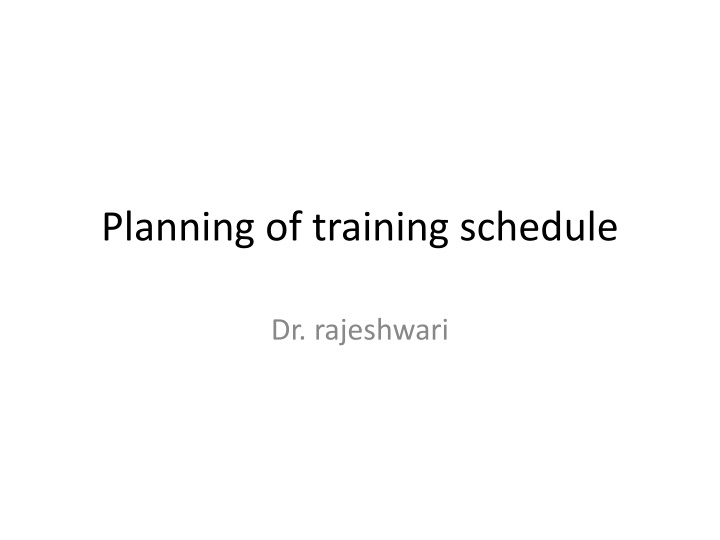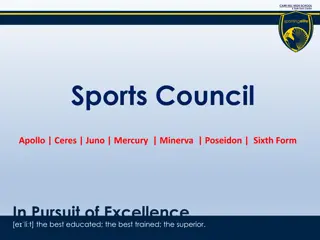Evolution of Training Planning and Periodization in Sports
The development of training planning in sports has a rich history starting from ancient times to the modern era. This evolution led to the introduction of periodization in the mid-20th century, focusing on structured training cycles and stress management for optimal athlete performance. The purpose of a Training Plan is to set achievable goals and outline specific activities to be carried out over short and long terms. Information gathering plays a crucial role in designing effective training plans by collecting personal details, performance objectives, and experience data. The systematic approach to planning training schedules has significantly contributed to enhancing athletes' overall performance.
Download Presentation

Please find below an Image/Link to download the presentation.
The content on the website is provided AS IS for your information and personal use only. It may not be sold, licensed, or shared on other websites without obtaining consent from the author.If you encounter any issues during the download, it is possible that the publisher has removed the file from their server.
You are allowed to download the files provided on this website for personal or commercial use, subject to the condition that they are used lawfully. All files are the property of their respective owners.
The content on the website is provided AS IS for your information and personal use only. It may not be sold, licensed, or shared on other websites without obtaining consent from the author.
E N D
Presentation Transcript
Planning of training schedule Dr. rajeshwari
Planning of training The way to controlled training process and meaningful planning of training was long, starting with the first of attempts and errors, leading to scientific based planning which has started to develop during the 19thCentury. Developing or training physical abilities has existed, though in a basic form at first, since the ancient times; it was used for Olympic Games preparation or for military purposes. First systematic principles in training were probably used by the Greek athlete Milon who implemented the principle of systematic planning as early as in the 6thCentury BC. He determined the training cycle by carrying a bull calf on his back each day until the animal reached maturity.
Modern scientific theories from the mid of 20thcentury formed the basis of training planning periodization. It was introduced to training practice in the 1950s and early 1960s when coaches realized that focusing on an important competition was preparing athletes for a year-round competition programme as the athletes are not able to withstand the enormous training load to which they were subjects. The roots and idea of periodization come from Hans Selye s model, known as the General Adaptation Syndrome which was first used by the athletic community in the late 1950s. Selye identified sources of biological stress and referred to them as eustress, which denotes beneficial muscular strength and growth, and as distress, which is stress that can lead to damage, disease, and necrosis of tissue. more effective than
The purpose of a Training Plan is to identify the work to be carried out to achieve agreed objectives. Training Plans should be drawn up to identify long-term (4 years) goals as well as short- term plans for the forthcoming season. For the rest of this topic, I will concentrate on the development of the short-term annual Training Plan. In its simplest form, the plan could comprise of a single, A4 sheet identifying the overall plan for the year, and more detailed weekly plans identifying the specific activities the athlete is to carry out.
Information Gathering The first stage of preparing a Training Plan is to gather background information about objectives for the forthcoming season. The sort of information to collect is as follows: Personal details Name, address, date of birth, telephone numbers, transport arrangements Objectives Performance (time, height, distance) Technical (development of event technique) Indoor and/or outdoor season Experience Personal best (PB's) Competition experience (club, county, national, country) your athlete and the
Equipment Does the athlete have his equipment (e.g. starting blocks, javelin, etc.)? Harness and tyre Elastic harness Weight jackets Video camera Distance, time, % effort matrix chart Finance Where can grants be obtained from? Competition Date of the main competition National andArea Championships School, University competitions Required qualification times for competitions Fixture lists - Club, County etc. Open Meetings Competitors Who are the competition and what are their PB's? Recent competition results Competition behavior
Athlete's other Commitments School, college, work, part-time jobs Family and partner Hobbies and other sports Time available for training Planned holidays Medical Previous injuries or illness Current problems (diabetes, asthma etc.) Access to medical support Physiotherapy support Training facilities Tracks and other running facilities (bad weather) Gymnasiums and weight training Swimming pools, saunas and massage Coaching Workshops Last season What can be learnt from last season - good and bad aspects Key questions for the athlete How serious are you about your athletics? What do you expect from your coach?
Analysis of the last program If this is not the first program you have generated with the athlete, then a vital activity to conduct is a SWOT analysis of the last training program: Strengths What were the best aspects of the program and why? What did we do well, and why? Weaknesses Are there gaps in the program? What did we not do very well, and why? Opportunities How can we enhance the program for the benefit of the athlete? Threats What may prevent us from achieving the short- and long-term objectives?
Athlete Assessment Before we can start to create a training program, we need to analyze our athlete to determine their strengths and weaknesses. The first step is to identify the ideal attributes (e.g. body build, speed, flexibility etc.) that will allow our athlete to achieve their agreed goals. The next step is to assess our athlete against our ideal athlete to identify their strengths and weaknesses (gap analysis). Addressing the gaps may require us to think in terms of long-term planning (4-8 years), but for this macro-cycle, we can set realistic but challenging goals to start to address the gaps. The following link provides an example form for this athlete analysis process strength, endurance,
Periodisation Periodisation is the method of organizing the training year into phases where each phase has its specific aims for the development of the athlete. The phases of a training year The training year is divided into 6 phases Objectives of each phase The objectives of each phase are as follows: Phase 1 - General development of strength, mobility, endurance and basic technique Phase 2 - Development of specific fitness and advanced technical skills Phase 3 - Competition experience - the achievement of indoor objectives Phase 4 - Adjustment of the technical model, preparation for the main competition Phase 5 - Competition experience and achievement of outdoor objectives Phase 6 -Active recovery - planning preparation for next season
Activities of each Phase The athlete's physical needs that require development are: Basic body Conditioning General and Specific Strength General and Specific Technique General and Specific Mobility General and Specific Endurance Speed Each of these needs should be seen as a building block, where specific blocks need to be in place before you progress to the next. Failure to do this may result in injury. How you allocate the blocks to each phase depends upon the athlete's weaknesses and strengths and is for you as the coach to decide with the athlete. One approach is to progress the building blocks as follows: basic body conditioning general strength, endurance, mobility and technique specific strength, endurance, mobility and technique speed
Athlete Development As an athlete matures, they are not only developing in terms of their sports but also education, career, physical maturity and their relationships with those around them. On average, an athlete is likely to face up to seven transitions during their full athletic, and perhaps the critical transition occurs around the age of 20 when they may be: moving to university/college or commencing in full- time employment progressing to a high-performance level maturing through adolescence establishing relationships with a partner Coaches must take into consideration these transitions when planning the annual and long-term training programs for their athletes.
What is a Macro-cycle, Meso-cycle, Micro-cycle? A Macro-cycle is a period (e.g. 11 months) defining the available preparation time up to a major competition. This can be divided into developmental periods called Meso-cycles. A Meso-cycle is usually 4-8 weeks in duration and has a specific objective, e.g. general preparation, specific preparation, competition. A Micro-cycle is a shorter training period of about 7-10 days and includes more detailed information on the intensity, frequency, duration and sequencing of the Training Sessions. What are a training unit and a training session? A training unit is a single activity (e.g. 6 60 metres at 90% effort with 2 minutes recovery) with a set objective (e.g. develop specific endurance). A training session is made up of one or more training units, e.g. warm-up unit, Technique drills unit, Speed Endurance unit and a cool-down unit. What is the training schedule? A training schedule (micro-cycle) comprises several training sessions that can span from 7 to 10 days.























